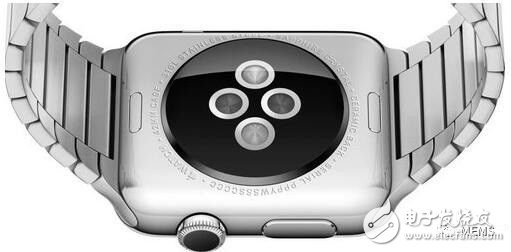According to foreign media reports, it usually takes some professional medical tools to measure blood pressure, but a patent released today by Apple describes a very simple blood pressure measurement method, which only needs to use Apple Watch and a table with sensors. The belt can be completed.

The basic principle of this patent is that if you can detect the heartbeat and then detect the pulse it produces on your wrist, you can know how long it takes from the heart to the wrist. This is called pulse transit time (PTT) and can be used to calculate blood pressure. The patent states that hypertension is a major risk factor for cardiovascular disease, and the sooner it is detected, the more likely it is to take measures to prevent accidents.
The patent shows that people can calculate the pulse transmission time by means of wristband devices and related measurement methods to achieve non-invasive blood pressure measurement. A wristband device includes an accelerometer, a blood pressure volume map (PPG), a pulse pressure sensor, and a controller.
The PPG, pulse pressure sensor is combined with the wrist device to detect the blood pressure pulse on the user's wrist. The controller processes the signal from the accelerometer, PPG or pulse pressure sensor to detect when the blood pressure pulse reaches the wrist and calculates the pulse transmission time and then generates one or more blood pressure values. The accelerometer detects the user's heartbeat, while the existing heart rate sensor detects the user's pulse.
As early as 2015, Apple CEO Cook said that Apple is cautious about the fact that the watch itself contains too many health-related sensors, because the slow process approved by the US Food and Drug Administration may hinder the progress of research and development. For example, Apple seems to have decided not to use heart rate sensors to measure oxygen saturation, even if the Apple Watch contains the necessary hardware.
However, earlier this year, the US Food and Drug Administration said its goal was to simplify digital health and medical technology innovation through a new regulatory device.
Extended reading:
Wearable Sensor Market - 2017 Edition
MEMS and Microsystems in Healthcare

In fact, what people usually call a pinhole camera does not use a pinhole lens. Pinhole lens refers to a lens that uses the principle of small hole imaging to obtain images. It is inexpensive and simple in principle, but its fatal weakness is that too little light passes through the small hole, resulting in too long exposure time. Taking photos with a pinhole lens in sunlight can take anywhere from a few minutes to a dozen minutes, especially when shooting at night with exposure times of up to several hours. Obviously, for a camera that shoots dozens to dozens of frames per second, it cannot meet the requirements. Pinhole lenses cannot be applied to cameras, so there is no "pinhole" camera in the strict sense. As is customary, a miniature camera using a fisheye lens, a flat lens or a conical lens is called a pinhole camera.
According to the lens, the lens of the pinhole camera can be divided into three types: fisheye lens, flat lens and conical lens; according to the photosensitive element used, it can be divided into charge coupled element and complementary metal oxide semiconductor; According to the data transmission method, it can be divided into two categories: wireless cameras and wired cameras.
Pinhole Hidden Camera,4k,High capacity battery
Jingjiang Gisen Technology Co.,Ltd , https://www.jsgisentec.com